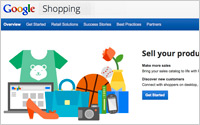 Google Product Listing Ads served on
Google Shopping and in search query listings are no longer free in the United Kingdom, Germany, France, Japan, Italy, Spain, Netherlands, Brazil, Australia, Switzerland and Czech Republic.
Google Product Listing Ads served on
Google Shopping and in search query listings are no longer free in the United Kingdom, Germany, France, Japan, Italy, Spain, Netherlands, Brazil, Australia, Switzerland and Czech Republic.
The
search engine said Thursday that it has begun to transition these countries from a free to fee-based model. With more companies signing on and seeing higher-than-average ROI, at least one platform
provider formed a business unit to support the move.
Google warned merchants and manufacturers to adjust accounts to adhere to the changes. A three-step list went up on the company's AdWords blog to ensure products remain eligible to appear in Google Shopping.
Google Product Listing
Ads perform well in the U.S. market, resulting in a 31% higher return on ad spend for the season, report Kenshoo findings from January.
Live data feeds from the retailer's or the
manufacturer's inventory system support Google PLAs -- so if stock runs out on the product the ad disappears, according to Dave Schwartz, who now oversees Datapop's newest business unit focused on
PLAs. "Optimization allows the product to serve up more often," he said. "Click-through and conversion rates are the two metrics considered most. We're looking for attributes that resonate most with
consumers."
Datapop's Creative Optimization platform tests what the viewer sees and the merchant's or manufacturer's product data feed. The technology aligns the product data feeds with
keywords searched. When optimized, the platform claims merchants can see between 40% and 50% of their search traffic from PLAs.
"Generally, PLA clicks convert at a slightly lower rate than
regular clicks for a similar product related search -- 70% to 100%," according to Kevin Lee, Didit founder. "The cost per clicks are also lower for the time being, so advertisers are generally
happy."
Aside from Datapop, platform providers and agencies have not taken the step to break out PLAs into a separate business unit, although Covario, Didit, IgnitionOne, Kenshoo, and Marin
support the ad unit.
Rolling PLAs into a mobile offering will require a little finesse. Limited screen space limits the view to a couple of products per page, and local merchants do better
than national.
Microsoft also plans to launch a PLA-paid offering soon.